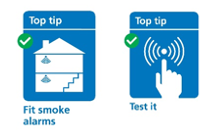Smoke alarms

In the event of a fire, early warning is crucial to give you time to escape safely. Smoke alarms are therefore the most important piece of safety equipment to have in your home. If they are working correctly, they can significantly reduce the risk of injuries and fatalities. If you have children in your home, talk to them about what the sound of a smoke alarm means and how they should respond.
The most effective type of smoke alarm for your home is a combination or multi-sensor smoke alarm. Have at least one smoke alarm installed on each floor of your home (e.g., in the hallway and landing) and in the rooms that carry the highest risk, such as living rooms and bedrooms.
Where shall I put them?
- Install on the ceiling, as close to the centre of the room as possible.
- Alternatively, mount the alarm on a wall, at least 30 centimetres below the ceiling.
- Avoid installing smoke alarms near windows, doors, air vents, or other openings, as this may affect their performance.
How do I keep them working?
- Use the button on your smoke alarms to test them weekly
- Replace expired batteries with new ones annually, or whenever the low battery warning sounds.
- Clean smoke alarms regularly to remove dust and debris that could affect their sensitivity.
- Replace smoke alarms every 10 years, or as recommended by the manufacturer.
How should I respond if the alarm sounds?
- Never ignore the sound of a smoke alarm, even if you suspect it could be a false alarm.
- Leave the building immediately, following your escape plan.
- Crawl low under smoke, if necessary.